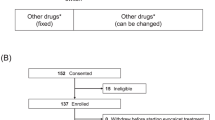Similar content being viewed by others
References
Slatopolsky E et al. (1999) Pathogenesis of secondary hyperparathyroidism. Kidney Int Suppl 73: S14–S19
Levin A et al. (2007) Prevalence of abnormal serum vitamin D, PTH, calcium, and phosphorus in patients with chronic kidney disease: results of the study to evaluate early kidney disease. Kidney Int 71: 31–38
Wolf M et al. (2007) Vitamin D levels and early mortality among incident hemodialysis patients. Kidney Int 72: 1004–1013
Coyne D et al. (2006) Paricalcitol capsule for the treatment of secondary hyperparathyroidism in stages 3 and 4 CKD. Am J Kidney Dis 47: 263–276
Coburn JW et al. (2004) Doxercalciferol safely suppresses PTH levels in patients with secondary hyperparathyroidism associated with chronic kidney disease stages 3 and 4. Am J Kidney Dis 43: 877–890
Goodman WG et al. (1998) Calcium-sensing by parathyroid glands in secondary hyperparathyroidism. J Clin Endocrinol Metab 83: 2765–2772
Delmez JA et al. (1989) Parathyroid hormone suppression by intravenous 1,25-dihydroxyvitamin D: a role for increased sensitivity to calcium. J Clin Invest 83: 1349–1355
Gunn IR and Gaffney D (2004) Clinical and laboratory features of calcium-sensing receptor disorders: a systematic review. Ann Clin Biochem 41: 441–458
Moe SM et al. (2005) Long-term treatment of secondary hyperparathyroidism with the calcimimetic cinacalcet HCl. Nephrol Dial Transplant 20: 2186–2193
Charytan C et al. (2005) Cinacalcet hydrochloride is an effective treatment for secondary hyperparathyroidism in patients with CKD not receiving dialysis. Am J Kidney Dis 46: 58–67
US FDA (online 5 July 2004) Sensipar (Cinacalcet HCI) Tablets Approval Application No.: 021688 [http://www.fda.gov/cder/foi/nda/2004/21-688_Sensipar.htm] (accessed 24 January 2008)
Health Canada (online 19 June 2007) Sensipar® no longer indicated for chronic kidney disease patients (stages 3 and 4) not receiving dialysis [http://www.hc-sc.gc.ca/dhp-mps/medeff/advisories-avis/prof/2007/sensipar_ hpc-cps_e.html] (accessed 22 January 2008)
Ba J and Friedman PA (2004) Calcium-sensing receptor regulation of renal mineral ion transport. Cell Calcium 35: 229–237
Author information
Authors and Affiliations
Ethics declarations
Competing interests
The author is a consultant, speaker, and investigator for Abbott, the maker of paricalcitol and calcitriol; an investigator for Amgen, maker of cinacalcet; and a consultant to INEOS, developer of an investigational phosphate binder.
Rights and permissions
About this article
Cite this article
Coyne, D. Cinacalcet should not be used to treat secondary hyperparathyroidism in stage 3–4 chronic kidney disease. Nat Rev Nephrol 4, 364–365 (2008). https://doi.org/10.1038/ncpneph0821
Received:
Accepted:
Published:
Issue Date:
DOI: https://doi.org/10.1038/ncpneph0821
- Springer Nature Limited





